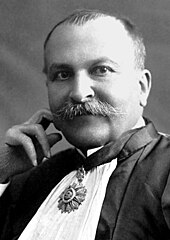Paul Sabatier (chemist)
Paul Sabatier (born November 5, 1854 in Carcassonne , † August 14, 1941 in Toulouse ) was a French chemist . He was a pioneer of catalytic hydrogenation in organic chemistry . Sabatier was awarded the 1912 Nobel Prize in Chemistry "for his method, organic compounds finely dispersed in the presence metals to hydrogenate , whereby the progress of organic chemistry has been promoted in recent years to a high degree."
biography
Sabatier studied from 1872 natural sciences with a focus on physics at the École normal supérieure and the École polytechnique . After graduating in 1877, he was a physics teacher at a grammar school (Lycée) in Nimes , but continued his studies in Paris in 1878 with Louis Pasteur and Marcelin Berthelot at the Collège de France and received his doctorate in 1880 with Berthelot on inorganic sulfur compounds. From 1880 he taught in Bordeaux (Faculté des Sciences) and from 1882 in Toulouse (in physics and chemistry). In 1884 he became professor of chemistry there. In 1930 he retired.
The medical and scientific university of Toulouse ("Toulouse III") bears his name. The Sabatier process , a methane extraction process , was named after him, but was developed with Jean Baptiste Senderens . With Senderens he found the process of catalytic hydrogenation, named after both: They let a mixture of hydrogen and ethene flow over finely divided nickel and found that ethane was formed. They succeeded in the hydrogenation of other unsaturated organic compounds in a similar way. However, they left the industrial implementation to others, for example Wilhelm Normann in fat hardening (but applied for a patent for hardening oils with their hydrogenation process , for example ).
The collaboration with Senderens, which began in 1892, ended in 1907 and later the two broke up, as Senderens had the impression that Sabatier was claiming joint discoveries for himself. Both received the Prix Jecker in 1905 . Two neighboring mountains on South Georgia are named after both. From 1901 he was a member of the Académie des Sciences . In 1918, Sabatier was elected a Foreign Member of the Royal Society , and in 1927 of the National Academy of Sciences . In 1934 he became an Honorary Fellow of the Royal Society of Edinburgh . The lunar crater Sabatier is named after him. The same applies to Mount Sabatier on South Georgia.
Fonts
- La catalyse en chimie organique 1912
literature
- Winfried Pötsch u. a. Lexicon of important chemists , Harri Deutsch 1989
Individual evidence
- ^ Paul Sabatier - Facts. In: nobelprize.org. August 14, 1941, accessed September 18, 2018 .
- ^ List of members since 1666: Letter S. Académie des sciences, accessed on February 24, 2020 (French).
- ^ Fellows Directory. Biographical Index: Former RSE Fellows 1783–2002. (PDF file) Royal Society of Edinburgh, accessed April 5, 2020 .
Web links
- Literature by and about Paul Sabatier in the catalog of the German National Library
| personal data | |
|---|---|
| SURNAME | Sabatier, Paul |
| BRIEF DESCRIPTION | French chemist |
| DATE OF BIRTH | November 5, 1854 |
| PLACE OF BIRTH | Carcassonne |
| DATE OF DEATH | August 14, 1941 |
| Place of death | Toulouse |
